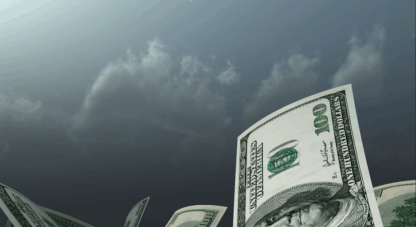View a Printable PDF Click Here
As Solomon was keen to advise, “Whoever walks with the wise becomes wise….” For that reason, I take special pleasure in speaking with many of our commentary guests, particularly including our recent guest Doug Noland. Doug’s background is quite impressive, but what really sets him apart is the quality of his analysis. He sees and understands things that the vast majority of economic and financial analysts never even notice. Reading his work and talking with him is an exercise in enlightenment on a grand scale – not to mention a great pleasure. If you missed our two-part interview with Doug on August 17th and 24th, I hope this excerpt will incline you to listen to it in its entirety.
* * *
David: Just as a bit of background, maybe you could share with us, you’ve been doing the Credit Bubble Bulletin since 1999.
Doug: My framework goes back to the early 1990s. I was working for a hedge fund out in San Francisco, a bearish hedge fund manager. We were professional bears. My first year in the industry was 1990. We had just phenomenal success. We were the geniuses. We had it all figured out, the economy was going into recession, a bear market, we were going to be rich.
Then came 1991, and all of a sudden the markets rallied. I started to try to understand how an impaired banking system kind of morphed into this new age financial system, driving not only the prosperity in the 1990s, but this phenomenal bull market. For me, it was an obsession to try to understand what was going on in finance, what was changing to fuel the boom. My attention went to asset-backed securities, mortgage-backed securities, Fannie and Freddie, and we were totally changing finance, we were moving away from the traditional banking system and bank lending driving finance to Wall Street finance. I just thought that this was an incredibly interesting period of time – an interesting development in the markets.
And then we started to have this wild financial volatility, we had the bear bond market in 1994, Mexican collapse, Southeast Asia. And then in 1998 you had Long-Term Capital Management and the collapse in Russia. These were spectacular booms and busts, and I was convinced that this new finance was fueling them, yet there was very little talk about any of this. The talk was still that only banks trade money, that banks drive credit, that the Federal Reserve controls all of this. I was saying, “No, no, it’s completely different than that.”
That’s why I started writing my blog. I thought there was a historic evolution in finance, this transformation that was getting very little attention. I was trying to title the blog, and then I decided, The Credit Bubble Bulletin, and I’m just going to chronicle this, and I thought maybe that “Bubble” would be in the title for a year or two. In 1999, I was convinced the bubble was about ready to burst. That bubble did burst, but then we had a new bubble, and in 2002 I started warning about the mortgage finance bubble. Never did I imagine we’d be in 2016 and I would still have “Bubble” in the title of my blog, and I would still be calling another bubble.
David: Janet Yellen, as recently as April of this year, has said that our economy is on solid ground – it is not a bubble economy. So clearly there is a contrast between the glasses through which she sees the world and the glasses through which you see the world.
Doug: Absolutely, and I remember the same comments in the 1990s – the new paradigm, “this is an age of financial stability.” We certainly heard a lot of that during the mortgage finance bubble period, that policy-makers were enlightened and that they had created a more stable environment. I just look at the situation as, we have this huge, huge bubble in securities, the biggest bubble ever, and it only appears stable because the central banks now are completely back-stopping it with zero and negative interest rates, with QE, which is, essentially, money-printing. We have over two trillion annualized QE in the world today. So, to me, it is a very unstable system that central banks, so far, have been able to sustain, and they are only sustaining it by making the bubble larger.
David: That is a reminder that there is a huge presumption of control on their part. What would you say that they can control versus what they think they can control?
Doug: This gets back to the 1990s. In the early part of that decade, the banking system was impaired. At Citigroup there was talk of it being insolvent. Part of what happened is, we had this non-bank credit growth – Fannie and Freddie and mortgage-backed securities, etc. The Greenspan Federal Reserve encouraged this growth because the banking system was impaired, and this securitized finance kind of got away from them. So they can only control it by incentivizing the hedge funds to leverage in order to keep money flowing into bond funds, even though the yields are so low.
So they’ve been able to control market expectations, and how they do that we saw in 2012 when Draghi came forward and said that the ECB would do whatever it takes. He wasn’t just speaking for the ECB, he was speaking for central bankers all over the world. And now we’ve seen the Bank of Japan, the Bank of England, the Chinese Central Bank, and the Fed basically say, “We will do whatever it takes to ensure there is not a crisis, to ensure there is not a bear market, to ensure there is not a recession.” And so far the participants in the market believe that’s true. They believe that QE goes on indefinitely to levitate the markets.
David: Is it the understanding of your average market practitioner that there are no negative consequences from that, or do they not care because the future is the future and the present is the present, and it’s only worth trading dollars in present terms, letting the future sort itself out?
Doug: I think it is short-termism everywhere. I think most people in the market know this is an unhealthy dynamic with the central banks, but the focus is performance that month, performance that quarter. In the financial markets, if you perform poorly, you don’t have much of a career. We see that for investors, portfolio managers, financial advisors, hedge fund managers. Everyone has to play the game today or they have to find something else to do with their careers. It’s a very unhealthy dynamic, but that’s how it has evolved.
David: It seems odd to me – we’re now in 2016, we had Ben Bernanke talking about an exit strategy for the Fed from its extraordinary policy measures back in 2011. As an add-on to that last question, why don’t market participants seem to care about the reliance on monetary policy experimentation in order to maintain the status quo? Are you boiling it down to self-interest? Is it that there is an outside faith in the Fed, that is they’ve done this, clearly, they’ll do even more if called upon? I don’t understand the rationale because it seems like it’s one desperate measure to the next and market participants aren’t seeing them as desperate measures at all.
Doug: Yes, it’s all become normal, I guess. Back in 2011 the Fed made public a very detailed exit strategy, and I think at the time they planned on winding down their balance sheet growth and normalizing interest rates. I titled one of my bulletins at that time “No Exit” because I thought it would be impossible for them to shrink their balance sheet that had grown to 2.1 trillion dollars. When I wrote that, I did not imagine that, instead of going back below a trillion, the balance sheet was on its way to 4½ trillion.
If you stand back and look at what has happened, it has been unimaginable that these central banks have inflated credit this way. We’re at a point now where the bubble is so big – and at least the sophisticated operators, a lot of the hedge fund managers, know the bubble is so big – they know central banks are trapped and have no choice but to back-stop the markets and continue to inflate securities prices. So that’s enough to keep players playing the game.
There can be a lot of money to be made at the end of a speculative bubble. We can think back to 1999. That’s the way these bubbles work. It gets crazy at the end, people lose a lot of money, but in the meantime some people can do pretty well, and if you don’t participate, you’re in trouble.
David: It’s like the alchemists of old who dreamed of creating gold, or money, from dirt. You have modern central bankers who have done one better. They can take modern money or credit – they can create it from nothing. It doesn’t even require the dirt.
There is a certain set of ideas that are popular among central bankers. I spoke to one British central banker six months ago who casually said, “Look, you can expand credit, you can expand your balance sheet indefinitely. It’s not a precursor to inflation because it will be sterilized.” So this idea that somehow what they’re doing does not have a consequence because they have a mechanism or a tool to take away the bad consequences – is it realistic?
Doug: I think future historians will be unkind. It will be very difficult to comprehend how this happened. As I said, in 2012 things turned – let’s just say crazy, where central banking completely took over global markets. For me, I mentioned that I thought the bubble burst back in 2000-2001 when tech crashed. In 2002 I had to change my tune, and that’s when I began warning of the mortgage finance bubble. Why? Because the Federal Reserve, specifically, was targeting mortgage credit to reflate the whole economy after the bursting of the tech bubble. I knew this was going to lead to pricing distortions in mortgage credit, housing inflation, and self-reinforcing speculation in the markets, especially mortgage credit.
When that bubble burst in 2008 I thought it was over. Well, in 2009 I had to change my tune again. I think it was April 2009 when I first started warning about the potential emergence of what I called the global government finance bubble, which to me was very troubling. It was dangerous enough to distort mortgage credit the way it was done, with all the government back-stops. What central bankers were doing, the Bernanke doctrine, basically, wanted to inflate security market prices, wanted to inflate central bank credit, wanted to inflate government debt.
So this bubble has gone not only global, because we’ve exported these types of excesses, it has gone to the heart of money and credit. What we have been doing is inflating central bank credit, government debt, the heart of the credit system, the heart of money, what people in the past have trusted. For me, that’s the most dangerous type of bubble. If you have a bubble in, let’s say, junk debt, that can be problematic. You can have a boom there. But you get to a point where that credit is risky, the market knows it’s risky, there is a limited demand for that type of credit, that bubble will not turn systemic. The mortgage finance bubble was much closer to money, people trusted the GSE credit, they trusted mortgage-backed securities, they trusted that government would back this debt.
That bubble ran for years, went to incredible excess, and became systemic throughout much more of the economy. But the global government finance bubble has gone to the heart of money and credit. It has gone global. I fear that when this bubble bursts the consequences will be immense; they will be enormous, profound. Because if people don’t trust central bank credit, don’t trust government debt, then they are not going to trust finance generally. That’s the type of credit crisis that could be global. The excesses in China have been extraordinary, so this bubble is much more troubling to me. I was very nervous in 2007 – much more nervous today. That any central banker can talk about this type of credit expansion not having consequences is really hard for me to listen to, to believe.
David: So we’re talking about the global government finance bubble, and it would appear that bubble dynamics don’t disappear. With intervention, they simply move up the food chain. When you have gotten to the government finance bubble, what comes after the government finance bubble? Are we at the top of the food chain?
Doug: Yes, that is my fear, and there is a lot of interesting theory with bubbles. They can go on for a long time, and that’s where we are today. The bubble has been going on for 25-30 years, so of course after that long of a period it seems like it can go on forever. But when that bubble bursts there is an inevitable crisis of confidence. At that point, how do you get the next bubble? For a new bubble to reflate the collapse of the old bubble, it has to be bigger.
I don’t know how the next bubble can be bigger. Not only have we gone to the heart of money and credit, we’re going to probably have three trillion dollars’ worth of credit growth in China this year. The global bubble went to China and the emerging markets, which were the global locomotive for the recovery after the collapse of the mortgage finance bubble back in 2002, 2008, and 2009. So it’s very difficult for me to see where the inflationary fuel can come from for the next bubble, which leads me to believe we will have QE almost indefinitely until the markets just lose faith in that type of credit.
* * *
This excerpt has been edited for flow and length. To listen to or read the interview in it’s entirety, be sure to go to mcalvanycommentary.com















